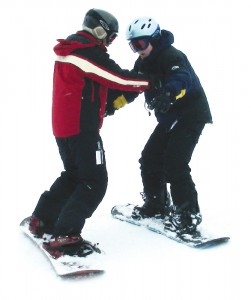by Dustin Semb
I enjoy teaching children. They are playful, fall down often, and have short attention spans; just like me. One more reason that I enjoy teaching children is the opportunity to be creative with my lesson, creative lessons usually equate to memorable ones for me. The monotony of teaching beginner adult group lessons every time we head to the hill can get to the best of us. So, I say we should fight monotony and go have some fun.

We all have heard that the best way to teach kids is to make the lesson fun. Many years ago I took an ACE (now called Children’s Specialist) clinic and learned a few things; the most important thing that I took away was the importance of making lessons fun. There are many ways to make a lesson fun, and quite a few of them rely on an instructor’s innate ability to relate with the kids.
One of the tactics we learned that was geared more towards a learnable skill was the Children’s Teaching Model: Play, Drill, Adventure, Summary. Here was something that we could use to make the lesson fun while adhering to a progression that would keep the parents happy, too. I started using PDAS the next day. What I soon discovered was that the children’s lessons I taught were fun and the learning curve was high, the adult classes were still a little on the boring side and we always seemed to get to basic skidded turns, but no further.
One day while teaching a father and son I had an epiphany. I was trying my best to teach the dad like an adult and the son like a child, using PDAS and Centerline (yes, I am that old) when I got my students flip-flopped and gave the dad games. He was the first adult student I had for weeks that looked like was enjoying himself and also learned to link turns. I thought “kids learn fast while having fun, why should that be any different with adults?” Since that day I have used the PDAS model with students of all ages with high levels of success.
PDAS works because you can easily tailor a lesson to the student’s idea of fun while keeping on track with your plan for improvement. The idea is that you take a skill and develop a game, drill, and adventure that work on that skill. The personality of each student determines the type of exercises you choose, Chutes and Ladders for some, Stratigo for others. The student gets to play, drill, and challenge him/herself while developing a solid skill set. Without the feeling of boredom there is repetition and practice of a skill.
In addition to the fun aspect, PDAS helps with “grouping” of learning. Grouping refers to our tendency to put like items together then combine those groups in order to create a whole concept. An example of grouping is counting coins. Many of us will group quarters in piles of 4, dimes in piles of 10 and dimes in 2 piles of 10, then count the piles to determine how many dollars we have. Our brain can process things in small groups easier than as a string of ideas. PDAS groups three exercises on one skill together, and then summarizes that skill before moving on to something else. Later in the lesson we can refer to a skill by mentioning one of the exercises we used and that whole segment of the lesson will pop up in the student’s mind.
Using the Children’s Teaching Model has helped me to provide a more enjoyable lesson for students of all ages and it has helped me breakdown what is being taught into groups that are easier to remember. I took a clinic on how to teach kids and eventually learned that adults group ideas together to remember them.
We should all be taking clinics like the Children’s Specialist 1 & 2 (formerly called ACE), the Freestyle Specialist and Senior Specialist training. Specialist training events are focused on one aspect of what we do but reach out and cross over to many other areas including teaching concepts, other snowsport disciplines, and professional knowledge.
[connections_list id=54 template_name=’div_staff_bio’]